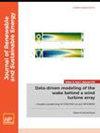基于混合时空图神经网络的多站点太阳辐照度预测
IF 1.9
4区 工程技术
Q4 ENERGY & FUELS
引用次数: 0
摘要
构建精确的时空相关性是对多个光伏站点进行联合预测的一项具有挑战性的任务。目前已经提出了一些先进的算法,如基于图神经网络的方法,这些方法通常基于静态或动态图来构建站点之间的空间依赖关系,从而纳入其他周边站点信息。然而,这些方法并未考虑同时存在多个空间依赖关系的可能性。本文建立了一个基于混合时空图神经网络的时空预测模型。在该模型中,我们应用自适应混合图学习来学习多个站点之间的复合空间相关性。多子序列时空数据输入的时空卷积模块用于提取局部语义信息,以更好地预测未来的非线性时空依赖关系。此外,还增加了一个时空自适应融合模块,以解决整合多个站点之间不同时空趋势的问题。为了评估该模型的预测性能,在两种不同的气候环境中选择了九个太阳辐射观测站。所建模型的平均均方根误差(RMSE)分别为 38.51 和 49.90 W/m2,平均绝对误差(MAE)分别为 14.72 和 23.06 W/m2。单站点和多站点预测模型被选为基准模型。与基线模型相比,所有站点的均方根误差和平均绝对误差分别减少了 3.1%-20.8%和 8.9%-32.8%。拟议模型证明了通过多站点预测提高太阳辐照度预测精度的有效性。本文章由计算机程序翻译,如有差异,请以英文原文为准。
Multi-site solar irradiance prediction based on hybrid spatiotemporal graph neural network
Constructing accurate spatiotemporal correlations is a challenging task in joint prediction of multiple photovoltaic sites. Some advanced algorithms for incorporating other surrounding site information have been proposed, such as graph neural network-based methods, which are usually based on static or dynamic graphs to build spatial dependencies between sites. However, the possibility of the simultaneous existence of multiple spatial dependencies is not considered. This paper establishes a spatiotemporal prediction model based on hybrid spatiotemporal graph neural network. In this model, we apply adaptive hybrid graph learning to learn composite spatial correlations among multiple sites. A temporal convolution module with multi-subsequence temporal data input is used to extract local semantic information to better predict future nonlinear temporal dependencies. A spatiotemporal adaptive fusion module is added to address the issue of integrating diverse spatiotemporal trends among multiple sites. To assess the model's predictive performance, nine solar radiation observation stations were selected in two different climatic environments. The average root mean square error (RMSE) of the constructed model was 38.51 and 49.90 W/m2, with average mean absolute error (MAE) of 14.72 and 23.06 W/m2, respectively. Single-site and multi-site prediction models were selected as baseline models. Compared with the baseline models, the RMSE and MAE reduce by 3.1%–20.8% and 8.9%–32.8%, respectively, across all sites. The proposed model demonstrates the effectiveness of improving accuracy in forecasting solar irradiance through multi-site predictions.
求助全文
通过发布文献求助,成功后即可免费获取论文全文。
去求助
来源期刊

Journal of Renewable and Sustainable Energy
ENERGY & FUELS-ENERGY & FUELS
CiteScore
4.30
自引率
12.00%
发文量
122
审稿时长
4.2 months
期刊介绍:
The Journal of Renewable and Sustainable Energy (JRSE) is an interdisciplinary, peer-reviewed journal covering all areas of renewable and sustainable energy relevant to the physical science and engineering communities. The interdisciplinary approach of the publication ensures that the editors draw from researchers worldwide in a diverse range of fields.
Topics covered include:
Renewable energy economics and policy
Renewable energy resource assessment
Solar energy: photovoltaics, solar thermal energy, solar energy for fuels
Wind energy: wind farms, rotors and blades, on- and offshore wind conditions, aerodynamics, fluid dynamics
Bioenergy: biofuels, biomass conversion, artificial photosynthesis
Distributed energy generation: rooftop PV, distributed fuel cells, distributed wind, micro-hydrogen power generation
Power distribution & systems modeling: power electronics and controls, smart grid
Energy efficient buildings: smart windows, PV, wind, power management
Energy conversion: flexoelectric, piezoelectric, thermoelectric, other technologies
Energy storage: batteries, supercapacitors, hydrogen storage, other fuels
Fuel cells: proton exchange membrane cells, solid oxide cells, hybrid fuel cells, other
Marine and hydroelectric energy: dams, tides, waves, other
Transportation: alternative vehicle technologies, plug-in technologies, other
Geothermal energy
 求助内容:
求助内容: 应助结果提醒方式:
应助结果提醒方式:


